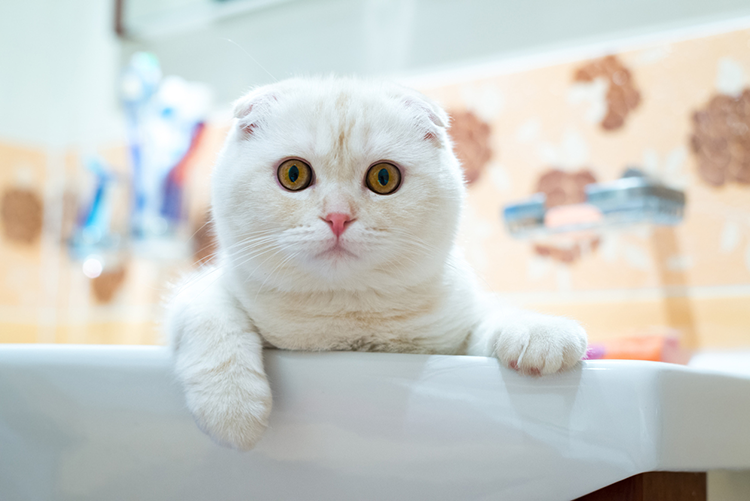It was 2 AM and Tiger Jack was straining in the litter box with no relief. Our middle-aged fluffy orange tabby had been agitated the entire day, pacing and crying piercingly. We found several spots where he’d squeezed a little urine out – the bathroom floor, the kitchen floor. Some of the urine was tinged red from blood. The entire situation was, in a word, terrifying – and I’m sure many cat-lovers are reading this now with a sympathetic wince. We all know how scary these situations can be!
We rushed Tiger Jack to the vet first thing the next morning, and were beyond relieved to find out his bladder was empty. He wasn’t trying to pee so often because his urethra was blocked; he was trying to pee so often because his urethra was irritated. The vet settled on a diagnosis of FLUTD (although he called it FUS – Feline Urological Syndrome, an old term – but he’s been in the business for well over 40 years, so I figure he’s allowed). Specifically, Tiger Jack suffers from FIC (Feline Idiopathic Cystitis.)
WHAT IS FLUTD?
FLUTD stands for Feline Lower Urinary Tract Disease, and it’s basically an umbrella term for a variety of conditions that affect your cat’s bladder and urethra. When your vet is investigating potential FLUTD in your cat, they may check for uroliths (stones in the urinary tract), a urinary tract infection, or obstruction of the urethra. Your vet may need to do a urinalysis or take x-rays or do blood work during their examination.
If stones are found, they can either be dissolved with a special diet or must be removed surgically. If the vet determines you cat has a bacterial (or fungal, parasitic, or viral) infection, your cat may need to be treated with antibiotics.
An obstruction of the urethra is the most serious concern with symptoms of FLUTD. If you suspect your cat has a blockage in his urethra, seek veterinary attention IMMEDIATELY! This is a life-threatening condition and is more commonly found in male cats due to their longer urethra. If your cat’s urethra is blocked, it could become a fatal condition in less than 48 hours. The blockage must be removed by your veterinarian, and additional treatment (such as fluids or antibiotics) may be required.
Feline Idiopathic Cystitis (FIC) is one of the most common conditions found in cats diagnosed with FLUTD. Essentially, FIC means that your kitty’s bladder and possibly urethra are inflamed and irritated – and your vet is not entirely sure of the underlying cause.
WHAT ARE THE SYMPTOMS?
Your cat may be suffering from a FLUTD condition if you observe any of the following:
- Your cat frequently visits the litterbox, straining to urinate.
- Your cat is trying to urinate outside the litterb box.
- Prolonged straining to urinate results in only small amounts of urine.
- Your cat cries while urinating or straining.
- You observe blood in your cat’s urine.
- Your cat is excessively licking his genital area.
These behaviors are definitely cause to take your cat to the vet ASAP.
WHAT ARE THE CAUSES OF FIC?
While vets are hard-pressed to provide a specific cause for idiopathic cystitis, there are a few contributing environmental factors they can point out. Stress is a big trigger of FIC, so anything you can do to relieve your kitty’s home-based stress is ideal. (This is just true for the general health of any pet, FYI.) Items and events such as their type of diet, changing their diet, changing your household routine, or introducing or losing a family member (cat, dog, person, whatever) can all contribute to a flare-up of FIC.
 For our buddy Tiger Jack, two big changes precipitated his FIC diagnosis: first, we adopted an 11-week-old calico kitten (her name is Rey and the Force is strong with her). The addition of Rey to our family meant certain parts of our home were closed off to prevent her from getting into dangerous mischief. It also meant keeping kitten chow down for her. Tiger Jack is very much the king of his domain, and did not think that he should be insulted by so many closed doors in his kingdom. He also kept getting into the kitten chow, which didn’t do him any favors.
For our buddy Tiger Jack, two big changes precipitated his FIC diagnosis: first, we adopted an 11-week-old calico kitten (her name is Rey and the Force is strong with her). The addition of Rey to our family meant certain parts of our home were closed off to prevent her from getting into dangerous mischief. It also meant keeping kitten chow down for her. Tiger Jack is very much the king of his domain, and did not think that he should be insulted by so many closed doors in his kingdom. He also kept getting into the kitten chow, which didn’t do him any favors.
According to our vet, some foods contribute to urinary issues in cats – wet food with fish ingredients can promote development of crystals in your kitty’s urine while too much dry food and too little water consumption can dehydrate your cat.
HOW CAN YOU TREAT FLUTD AT HOME?
First off, you should consult your vet for their professional instructions on how to treat your cat’s FLUTD. You may need to administer medication or change your cat’s diet. In our case, Tiger Jack was prescribed a urinary tract health formula dry food, and we increased the amount of wet food he consumes each day. (We no longer get any fish flavors!) We also placed additional water bowls throughout our home. To relieve his stress, we found ways to make more of the house available to him. And as far as Rey goes? He fell in love with her, even if he’s still occasionally “get the hell off my lawn!” at the new kid. So that’s okay.
Tactics you can try to treat your cat’s FIC:
- Reduce stress – remove environmental stressors, play daily with your cat, give them plenty of places to escape and relax.
- Be proactive with conflict resolution – any of your pets not get along? Do positive reinforcement exercises to improve their relationships.
- Provide a relaxed cat box experience, by having enough cat boxes for your cats (generally one per cat, plus an extra) located in a safe space; make sure cat boxes are cleaned daily.
- Encourage hydration with multiple clean water sources scattered around your home.
- Change your cat’s diet to include more wet food, and try feeding them quality dry food formulated for urinary tract health.
The manifestation of FLUTD symptoms can be a terrifying time, so take a deep breath and methodically do the right things: visit your vet, medicate as directed, and make what changes need to be made. FIC is a treatable condition: you just need to be vigilant and proactive!






